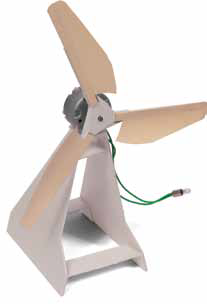The Eco-Wind Generator
By Ken Roberts
Posted on 2012-04-25
The Eco-Wind Generator is a fun little gadget that middle to high school age students can put together relatively easily and get a decent amount of qualitative data about its performance. It has the ability to be used in inquiry and engineering projects for several different science topics. This may be a good option for a project for a group or partners. I had an eighth-grade student put the wind generator together following the instructions, without any assistance. The student was able to put it together with ease in about 20 minutes (it may take longer for students who are not proficient at reading instructions or have little building experience). The light attached to the motor is a good way for students to qualitatively see how well their generator is functioning, though using a multimeter will show the data more quantitatively. The generator is open for engineering inquiry, with the ability for students to create their own blades (changing shapes, materials, etc) to see how those change the intensity of the light and/or the voltage. In addition, it can be used to demonstrate other topics (according to the idea section of the instructions), though those may depend on students’ welding skills. Students must be very specific in their placement of the motor and the creation of the blades, otherwise the generator will not work correctly. Small misplacements can cause the blades to hit the base. If students have already hot glued it incorrectly, they can damage the top of the base when trying to remove the motor to re-glue it. The blades can also be bent in the wrong way irreparably, though card stock paper can be used to replace the blades. Using materials other than hot glue, tape for example, will not work. The structure will not be stable and will have a tendency to lean since the motor is heavy. You also have to be sure to put on enough hot glue to ensure stability. Be careful when using the hot glue gun, however, that you don’t r uin the sleek design of the generator. Hot glue can leave little “spider web trails” everywhere, which can reduce the generator’s efficiency if the “trails” get on the moving parts of the motor. This product is easy to use and would work well with a class of students (about two students per kit) as a building project. Students should be able to build this kit with minimal oversight if they take care during building and review the instructions before beginning construction. To make the kit even more useful to the classroom teacher, it would have been nice if Pitsco had included some basic information about how the motor functions, the difference between voltage and amperage, and a list of resources related to wind-generated power. Lesson plans are available at http://shop.pitsco.com/activities/ section.aspx?CategoryID=70.
Disclaimer: The views expressed in this blog post are those of the author(s) and do not necessarily reflect the official position of the National Science Teaching Association (NSTA).



